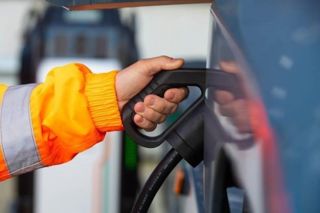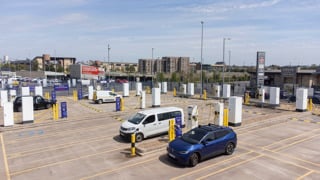Around two-thirds of Britain’s most common type of public charge points suffer from limited mobile phone connectivity, new research from the RAC Foundation suggests.
The patchy mobile signal coverage means drivers of electric cars could be facing problems when they seek to fill up.
The majority of public charge points – more than 31,000 of the 53,000-plus chargers at the start of the year – have speeds up to 8kW, so-called Type-2 charge points.
However, unlike faster charge points, chargers below 8kw are not obliged to provide for contactless payment, with the vast majority requiring drivers to access them via mobile phone apps.
What is more, says the RAC Foundation, most chargers themselves also need an adequate mobile signal connection to function.
Britain has four mobile network providers: EE, O2, Three and Vodafone, on which other companies – Giffgaff, Tesco Mobile etc. – can piggyback.
Unless all four are providing adequate signal coverage at the charge point location there is a risk that either the user or the charger will lack the connection needed to unlock the flow of electricity.
Steve Gooding, director of the RAC Foundation, said: “In many instances the mobile phone has become the key to unlocking the potential of the electric car. Unfortunately, that key does not always work.”
The RAC Foundation analysed a randomly selected sample of 2,059 Type-2 public chargers across Britain.
The research reveals that the majority of these chargers do not have an adequate level of coverage from all four mobile phone network providers to guarantee they can be activated 100% of the time.
In Britain, outside of London, just a third of the Type-2 chargers analysed are in locations where there is acceptable all-network 4G coverage.
Two-thirds are in spots where a signal from one, two, three or even all the providers is absent or too weak to work.
In London, the picture is only slightly better at 39.7% and 61.3% respectively.
Where a 4G signal is absent then a residual 3G signal might still be available, but the national 3G network is due to be shut down completely by 2033.
Vodafone has already turned off its 3G network with EE and Three expected to complete their shutdowns later this year, and O2 next year.
The mobile signal strength data used in the analysis was provided by Teragence. This data was then matched to the 2,059 chargers used in the study.
Gooding said: “The mobile phone is already deeply embedded in our daily lives, not least when it comes to driving where we rely on a good mobile connection to inform our sat navs, pay for parking and to unlock electric chargers.
“But all these systems need to be designed with an eye sharply focused on real-world network coverage, which is often patchy, sometimes non-existent, and not about to become infinitely better.
“Where signal connectivity at a charge point is a problem drivers might conclude that the charger is at fault hence undermining the confidence we should be building in the reliability of public charging options for electric vehicles.
“What’s more, the poor connectivity won’t get picked up in the new mandatory reporting system applying only to the rapid charger network.”
Where adequate mobile phone signal coverage is unavailable workarounds could include: signposting the availability of a limited wi-fi hotspot for drivers to use (e.g. in the on-charger instructions for use) if the charge point’s connection is robust but the motorist’s might not be; and use of roaming SIM cards (i.e. from other countries), which have become increasingly common, so that connectivity can adjust by roaming to whichever mobile network is most robust at a given moment.
Further workarounds could include: use of external and/or directional antennae for more reliable data connections; making roaming RFID (Radio Frequency Identification) cards more widely, and freely, available to remove the motorist’s phone from the equation; improvements to signal quality through the Single Rural Network (SRN) programme of mast sharing between mobile network operators; satellite internet provision from operators like Starlink and OneWeb; and, as a fallback, when the issue is an unresolvable signal connectivity failure, the charger itself could be set to default to provide a free charge up to a limit that would at least guard against a potential breakdown for lack of a sufficiently charged battery.
Gooding continued: “In order to design reliable connected services that work for motorists we need a better approach to assessing and reporting the adequacy of on-the-move connectivity so that designers, including electric charge point providers, can select which of the readily available workarounds would cover for the shortcomings of the mobile networks.”
The full study can be downloaded here.























Login to comment
Comments
No comments have been made yet.